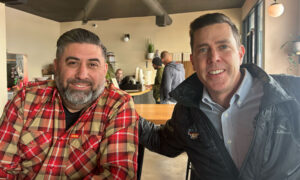Takeaways:
- Political primary system and partisan news media are polarizing forces
- Urban and rural Americans share many values, despite stereotypes of their differences
- Intense partisanship has been historically persistent in the U.S.
By several measures, Americans are growing more divided. Studies show the U.S. is polarizing faster than other democracies, while members of Congress are farther apart ideologically than they’ve been in 50 years. One survey suggested many Americans would like to split the country literally – agreeing that states should secede from the union.
But the divisions among Americans are not as deep – or historically unusual – as you may think, according to experts from the USC Sol Price School of Public Policy. Still, there are several factors fueling polarization, from political primaries to partisan news media.
USC Price School professors Elizabeth Currid-Halkett and Jeffery A. Jenkins recently discussed the political and cultural divides during a panel discussion at the Los Angeles Times Festival of Books. The panel also included Geoffrey Cowan, director of the USC Annenberg Center on Communication Leadership and Policy. It was moderated by Robert Shrum, director of the USC Dornsife Center for the Political Future, which advances civil dialogue and research that transcends partisan divisions.
“The rule in the United States is for polarization and intense partisanship. That has been what we normally have.”
Jeffery A. Jenkins, USC Price School Provost Professor
Political divisions in the U.S. are often framed in geographic terms, contrasting urban and rural America. But Currid-Halkett, who authored the forthcoming book “The Overlooked Americans” about the rural U.S., said people from these different parts of the country share many values, from opposing racism to supporting environmental protection.
Why, then, did rural Americans support former President Donald Trump?
“People are multitudes. All of us are. We are contradictions,” said Currid-Halkett, the James Irvine Chair in Urban and Regional Planning at the USC Price School and a recipient of a Guggenheim Fellowship. Currid-Halkett went on to explain that rural Americans may have voted for Trump but that is not mutually exclusive to caring for our environment, our democracy and believing in equality for all.

“Rural America has been increasingly voting Republican for decades now,” she said. “I think that Trump and his cult of personality may make us think, ‘Oh my gosh, they’re voting for Trump,’ when actually what they’re doing is voting for Republicans.”
Jenkins, the USC Price School’s Provost Professor of Public Policy, Political Science, and Law, noted that many rural Americans leaned Democrat decades ago. He cited partisan news outlets like Fox News for stoking divisions, as well as leaders in the Democratic Party who used rural Americans as a political foil.
“So, Trump is the culmination of this rather than beginning the trend,” Jenkins said.
Political insiders and observers lament the lack of bipartisanship in Congress, contrasting it with the mid-20th century when politicians more often reached across the aisle to pass new laws. However, that period was the exception, not the rule, during the nation’s 245-year history, according to Jenkins, a political historian whose books include “Republican Party Politics and the American South, 1865-1968” and “Congress and the First Civil Rights Era, 1861-1918.”
“The rule in the United States is for polarization and intense partisanship. That has been what we normally have,” Jenkins said. “And when we look back to the middle part of the 20th century as a golden era, we have to remember that a lot of that bipartisanship came with Republicans and Southern Democrats joining forces to limit the power of labor and African American rights.”

“I don’t think that we should necessarily think of that as a golden era,” he added.
The changing media landscape also plays a role in polarization, with the rise of partisan cable news channels, the decline of local newspapers and the proliferation of online misinformation. With legitimate news outlets putting content behind paywalls to raise revenue, many Americans turn to less credible sources such as social media and YouTube videos, Currid-Halkett said.
“I think the news media has a duty to provide more news and information. High quality media is hard to get a hold of, so then we remain in these silos,” she said, which furthers perceived differences and polarization.






